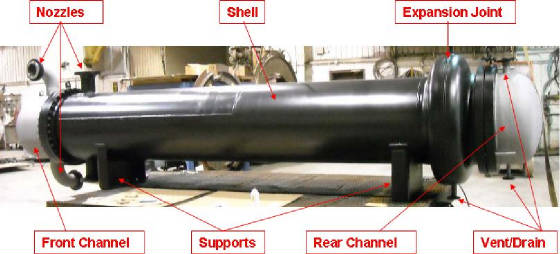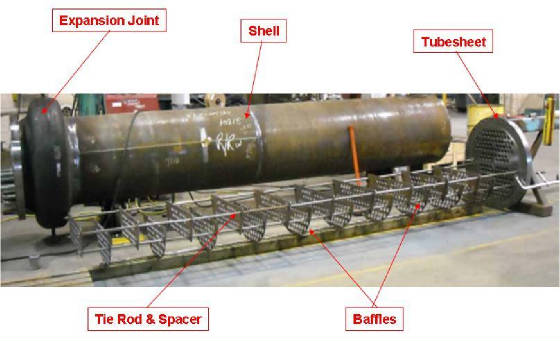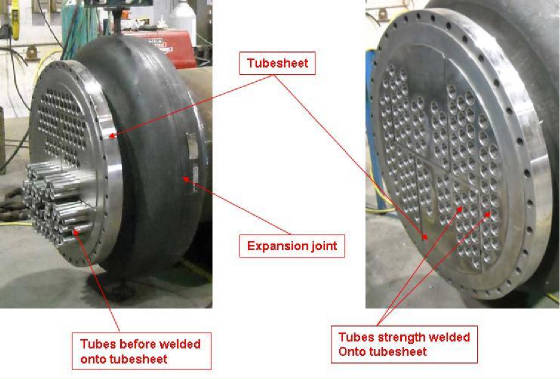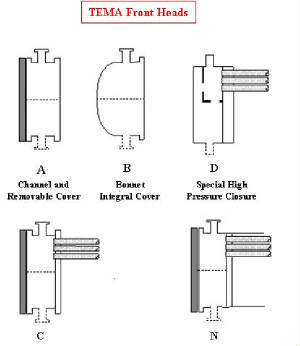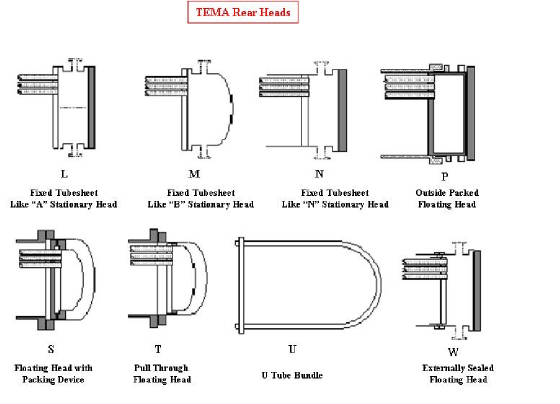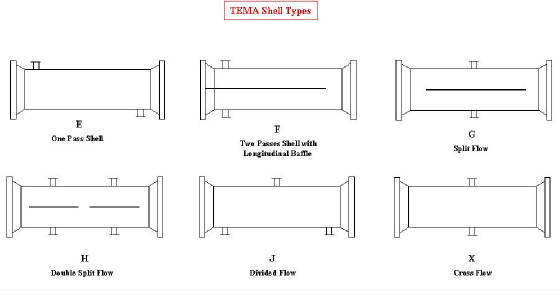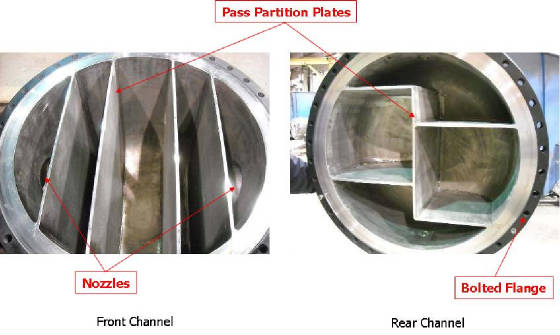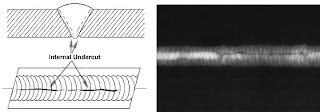INSTALLATION1. Provide sufficient clearance at the channel or bonnet end of the unit to permit removal of tube bundles from shells. On the floating head end, a space of 3 or 4 feet should be provided to permit the removal of the floating head.
2. Foundations must be adequate so that exchangers will not settle and cause piping strains. Foundation bolts should be set to allow for setting inaccuracies. In concrete footings, pipe sleeves at least one size larger than the bolt diameter slipped over the bolt and cast in place are best for this purpose, as they allow the bolt center to be adjusted after the foundation has set.
3. Provide valves and by-passes in the piping system so that both the shell and tube bundle may be by-passed to permit cutting out the unit for inspection or repairs.
4. Provide convenient means for frequent cleaning of the unit as suggested under "Maintenance."
5. Provide thermometer wells and pressure gage connections in all piping to and from the unit, as near the unit as possible.
6. Provide necessary air vent cocks so that the unit can be purged to prevent or relieve vapor or gas binding of either the tube bundle or the shell.
7. Loosen foundation bolts at one end of the unit to allow free expansion of shell. Oval holes in foundation brackets are provided for this purpose.
8. Set exchangers level and square so that pipe connections may be made without forcing.
9. Inspect all openings in the heat exchanger for foreign material. Remove all wooden plugs and shipping pads just before installing. Do not expose units to the elements with pads or other covers removed from nozzles or other openings since rain water may enter the unit and cause sever damage due to freezing and/or corrosion.
10. Be sure entire system is clean before starting operation to prevent plugging of tubes or shell side passages with sand or refuse. The use of strainers or settling tanks in pipelines leading to the heat exchanger is recommended.
11. Drain connections should not be piped to a common closed manifold.
12. To guard against pulsation of the fluids caused by reciprocating pumps, compressors or other equipment a surge drum should be installed.
OPERATION:
A heat exchanger is a pressure vessel designed for operation at certain specific limits of pressure and temperature, and the system must be safeguarded with safety valves and controls so that these design conditions are not exceeded and that all operating personnel are alerted.
1. When placing a unit in operation, open the vent connections and start to circulate the cold medium only. Be sure that the passages in the exchanger are entirely filled with the cold fluid before closing the vents. The hot medium should then be introduced gradually until all passages are filled with liquid. Then, close vents and slowly bring the unit up to temperature.
2. Start operation gradually. Do not admit hot fluid to the unit suddenly when it is empty or cold. Do not shock unit with cold fluid when it is hot.
3. In shutting down, flow of hot medium should be shut off first. If it is necessary to stop circulation of cooling medium, the circulation of hot medium should also be stopped by by-passing or otherwise.
4. Do not operate equipment under conditions in excess of those specified on nameplate.
5. In all installations, there should be no pulsation of fluids since this causes vibration and strain with resulting leaks.
6. All gasketed joints should be rechecked for tightness after the unit has been heated to prevent leaks and blowing out gaskets.
7. Units with packing rings may require adjustment from time to time to eliminate slight leakage. As joint containing packing rings requires only a small amount of bolting pressure to seal tight.
Many heat exchangers handle fluids which are irritating or dangerous to the human system and could cause problems if bolted and packed joints are not maintained in a leak tight condition both at operating pressures and temperatures, and also at no flow, ambient conditions.
If fluid are not irritating or dangerous a leak will at least cause a slippery situation on the floor below.
Since one fluid in the exchanger is at a higher temperature, any leaks might cause burns.
If leakage should appear at the packed end joint after the cooler is placed in operation, the bolting should be pulled up only enough to stop it. This can be accomplished by taking a one-half turn on each successive bolt starting at one point and continuing around the cooler until all leakage has been eliminated. Do not tighten this joint any more than is required to stop the initial leakage.
When the packing has been repeatedly tightened to the point where there is almost a metal to metal contact between the bonnet (or channel) and the shell flanges, the two packing rings should be replaced.
8. Be sure that all parts of the system are clean and in proper operating condition. An exchanger cannot perform properly unless all connected equipment is functioning properly, yet, the exchanger is frequently blamed for non performance when the actual trouble is elsewhere in the system.
Observe the following precautions to obtain maximum performance:
(A) Exchanger must be full of fluid in both shell and tube sides.
(B) Provide periodic venting if air tends to accumulate in system.
(C) Maintain rated flow of both mediums.
(D) Avoid excessive flow of cooling water in exchangers used as coolers. It is a frequent cause of tube failure through erosion, and may decrease cooling efficiency, especially with heavy oils.
(E) Inspect exchanger periodically and clean thoroughly when necessary, especially inside tubes.
MAINTENANCE:
1. Provide convenient means for frequent cleaning of heat exchangers as suggested below:
(A) Circulating hot wash oil or light distillate through tubes or shell at a good velocity will usually effectively remove sludge or
similar soft deposits.
(B) Soft salt deposits may be washed out by circulating hot fresh water.
(C) Some commercial cleaning compounds such as “Oakite” or “Dowell” may be effective in removing more stubborn deposits. Use in accordance with the manufacturer’s instructions.
(D) If none of the above described methods are effective for the removal of hard scale or coke a mechanical means may be used.
When the heat exchanger is cleaned, it is important the full characteristics of the fouling material and the cleaning agent be known and care exercised in handling them according to instructions.
2. Frequently and at regular intervals, observe interior and exterior condition of all tubes and keep them clean. Neglect in keeping all tubes clean may result in complete stoppage of flow through some tubes, with consequest overheating of these tubes as compared to surrounding tubes, resulting in severe expansion strains and leaking tube-to-tube-sheet joints.
When shutting down for repairs it is imperative that all fluids be drained from the heat exchanger and that no bolting be loosened until the pressures are down to atmospheric and the temperature of the parts are down to ambient.
3. Do not attempt to clean tubes by blowing steam through individual tubes. This overheats the tube and results in severe expansion strains and leaking tube-to-tube-sheet joints.
4. Do not blow out heat exchanger with air when fluids normally handled are of an inflammable nature.
5. Do not open heads until all pressure is off equipment and the unit is drained.
6. Do not handle tube bundles with hooks or other tools which might damage tubes. Bundles should be moved about on cradles or skids.
7. Do not tighten bolts until gasket is positioned properly. This precaution will eliminate one cause for taking down units because of leaks.
Since many of the removable components of the heat exchanger, particularly in the larger sizes are too heavy for men to handle care must be used to take this weight with proper rigging to avoid injury.
When a heat exchanger is dismantled for any cause, it is recommended that new gaskets be used in re-assemble. This will tend to lessen the possibility of future leaks because composition gaskets become brittle and dry out, they do not provide an effective seal when reused. Metal or metal jacketed gaskets when compressed initially tend to match their gasket contact surfaces. In doing so, the are work hardened to the point that their reuse provides an imperfect seal and possible damage to the gasket contact surfaces of the heat exchanger.
8. To tighten a loose tube joint, use a suitable roller type tube expander. Do not roll tubes that are not leaking as it needlessly thins the tube wall.
9. Exchangers subject to fouling or scaling should be cleaned periodically. A light sludge or scale coating on the tube greatly reduces effectiveness. A marked increase in pressure drop and/or reduction in performance usually indicates cleaning is necessary, if the unit has been checked for air or vapor binding and this has been found not to be the cause. Since the difficulty of cleaning increases rapidly as the scale thickens or deposit increases, the intervals between cleanings should not be excessive.
10. To clean or inspect inside of tubes, remove channel covers (or bonnets). Do not remove channels.
11. To locate leaking joints between tube and tube sheet or a split tube, proceed as follows:
Channel Type
(a) Remove channel covers
(b) Apply hydraulic pressure in shell
Bonnet Type
(a) Remove bonnets
(b) Bolt test rings in place with gaskets and packing
(c) Apply hydraulic pressure in shell
Use only cold water for hydrostatic test. The point where the water escapes indicates the defective tube or joint.
12. when removing tube bundles from exchangers for inspection or cleaning, care should be exercised to avoid damage by improper handling. Although tube bundles are often of great weight, the tubes are small and of relatively thin metal. The dead weight of the bundle, therefore, should never be supported on individual tubes, but should rest on those parts that are designed to carry it i.e., the tube sheets, support plates or wood blocks, cut to fit the periphery of the bundle. In withdrawing tube bundles, it is recommended that rods or steel cables be passed through two or more of the tubes and the load taken on the floating tube sheet. Rods should be threaded and provided with nuts and should pass through a bearing plate at either end of the bundle. A soft wood filler board should be inserted between bearing plates and tube sheets, in order to prevent damage to tube ends. A forged steel eye bolt which may be screwed into either plate is used for pulling and lifting.
When steel cables are used for lifting, the cable is threaded through one tube and returned through another. Loops are formed in the ends of the cable by use of thimbles and wire rope clips. A wood spreader block is inserted between the cable and the floating tube sheet to prevent crushing on tube end.
If the tube bundle has been in service for a considerable length of time without being removed it may be necessary to use a hydraulic jack on the floating tube sheet to get it started. A good sized steel bearing plate should be inserted between jack and tube sheet and the tube ends protected by means of a filler board.
Tube bundles may be raised horizontally by means of slings. Baffles can be easily bent & damaged by dragging a bundle over a rough surface. Diameter of baffles is practically the same as the inside of the shell and a close fit must be maintained for the apparatus to function properly. Any damage to baffles should, therefore, be carefully avoided.
In cleaning a tube bundle, tubes should not be hammered on with any metallic tool. In case it is necessary to use scrapers, care should be exercised to see that the scraper is not sharp enough to cut the metal of the tubes.
![]()
![]()
![]()

















